The approximate geographical locations of where the coins were issued can be seen on this map
(identify coins by their coin numbers). Coins of large empires are located in the area of the presumed capital cities.

|
|
|
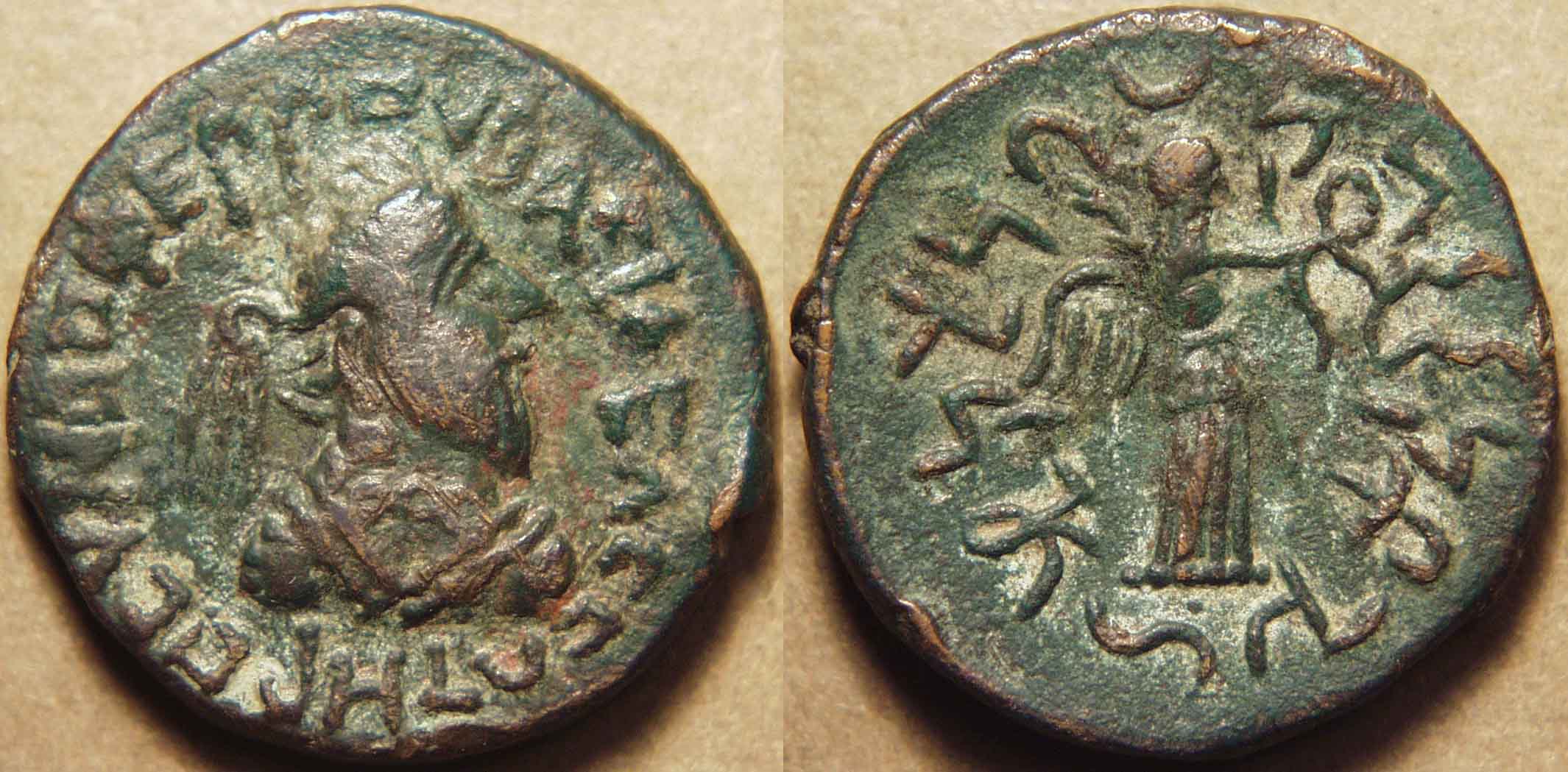
|
Coin #11:
Indo-Parthian Kingdom, Gondophares I, AE Octadrachm, c. 1st century CE
Bust of king right, Greek legend around:
BACIΛEΩC CΩTHPOC YNΔOΦEPPOY /
Winged Nike standing right, holding diadem, Kharoshthi legend around:
Maharajasa Gudaphanisa tratarasa
Weight: 19.10 gm., Diam: 28 mm.
Ref: Senior, ONS Newsletter, No. 171 (Spring 2002) |
|
In the early years of the new millennium, the Indo-Scythians faced a challenge from an entirely new source: Parthian warriors from Persia. Led by the great king Gondophares,
the Indo-Parthians established a powerful kingdom that lasted approximately a hundred years. Coin 11 is a unique bronze octadrachm of Gondophares. Although many
tetradrachms are known for this ruler, this is the only known octadrachm. The design follows closely that of the Indo-Greek kings: a bust of the king right surrounded by a Greek
legend, and a deity surrounded by a Kharoshthi legend on the reverse. The deity here is a winged Nike, appropriate for a victorious conqueror, and a common subject among
the Indo-Greeks, the Indo-Scythians, and the Indo-Parthians.
The date of Gondophares is a matter of great contoversy. He has been equated with one "King Gudnaphar" mentioned in the Apocryphal Acts of St. Thomas, an early
Christian text. As St. Thomas met this King Gudnaphar, the date for Gondophares necessarily had to be no earlier than approximately year 20 CE. However, Robert Senior has
argued that the King Gudnaphar of the Acts was probably Gondophares-Sases, who succeeded Abdagases, the successor to Gondophares I. On the basis of
numismatic evidence, Senior dates Gondophares 70 years earlier than the conventional date.
|

|
Coin #12:
Satavahana Kingdom, Vasithiputra Pulumavi, Silver drachm, c. 1st century CE
Bust of king right, Prakrit Brahmi legend around:
Siri Pudumavisa Rano Vasithiputasa /
Ujjain symbol, chaitya and river, Telugu legend around:
Arahanaku Vahitti Makanaku Tiru Pulumaviku
Weight: 1.81 gm., Diam: 15 mm.
Ref: MKA 146 |
|
We have already seen two coins of kingdoms that arose following the collapse of the Mauryan empire: the Pandyas in the south and the Mitras of Panchala in the north. Coin 12
represents a powerful kingdom that arose at this time in south central India: the Satavahanas or Andhras. The Satavahanas were feudatories of the Mauryas who asserted their
independence when the central power weakened after the death of Ashoka. Most of their coinage is in copper, but there is a rare portrait series in silver based on Indo-Greek
prototypes of which this coin is an example. It is an issue of Sri Pulumavi, and features a bust right of the king, surrounded by a Prakrit legend in Brahmi letters on the obverse,
and a reverse containing some symbols surrounded by a legend in Telugu, the local language. The central symbols include a so-called "Ujjain" or "Satavahana" symbol
consisting of a cross with globes at the ends of its arms and a Buddhist chaitya, or hill symbol.
One of the most interesting aspects of the Satavahana portrait coins is that the kings identify their matrilineal line. The legend on our coin reads: Siri Pulumavisa Rano
Vasithiputasa, or "King Sri Pulumavi, son of Vasithi." The king identifies his mother, not his father. There are still some communities in India that follow the matrilineal line.
Another interesting aspect of this coin is the obvious Roman influence, seen very clearly in the portrait style. This is a reflection of the thriving trade that emerged between Rome
and the kingdoms of central and southern India in the 1st century. This trade came about primarily as a result of the discovery of the monsoon winds, which made for a swift
journey from Arabia to India. |

|
Coin #13:
Kushan Empire, Kanishka I, gold dinar, c. 127-147 CE
King standing facing, holding spear and goad and sacrificing at fire altar left,
Bactrian legend around: Shaonanoshao Kaneshki Koshano /
Solar deity Mithra standing left, nimbate, holding sword hilt with left hand,
right hand outstretched in benediction, Bactrian legend at right: Miiro, tamgha at left
Weight: 7.97 gm., Diam: 20 mm.
Ref: Göbl 31 |
|
During the 1st century, the unsettled conditions in the northwest, with Indo-Parthians and Indo-Scythians vying for supremacy, finally calmed down with the establishment of an
entirely new military force: the Kushans. This was a tribe with its origins in southern China, which had been forced to migrate west by competing tribes in their homeland. Towards
the end of the millennium, the Kushans began to make forays into Bactria. After a period of struggle, they gained the upper hand, and, by the end of the 1st century had clearly
gained a position of dominance throughout northwestern India.
Perhaps the greatest and most well-known Kushan king was Kanishka, who ruled c. 127-147. His realm extended from Uzbekistan and Tajikistan through Afghanistan and
Pakistan, all the way through much of northern India. Thus he ruled over a vast empire. His fame further stems from the tradition in the Buddhist literature that he convened the
fourth Buddhist Council in Kashmir during his reign. He also built an immense stupa to house some relics of the Buddha in his capital city of Peshawar. Coin 13 is a gold dinar of
this great king. Although gold coins had been minted by his father Vima Kadphises, Kanishka introduced a large number of new gold coin varieties. One of the most interesting
aspects of this coinage is that many different deities are featured on their reverses, including deities from several different traditions. We find on Kanishka's coins Greek gods
such as Helios and Salene, Iranian gods such as Nanaia, Mithra (as on this coin), Mao and Athsho, Hindu gods such as Shiva and Kartikeya, the Zoroastrian deity Ahura
Mazda and the Buddha. Most authors believe that this broad pantheon of deities indicates that Kanishka's reign was characterized by tremendous religious toleration.
Another aspect of the fact that Kanishka placed many different deities on his coins is that they provide powerful evidence of the syncretic nature of many of these deities from
different traditions. For example, an earlier issue by Kanishka featuring the Greek solar deity Helios shows that deity represented identically to the way the Iranian solar deity
Mithra is represented (see that coin here): both are nimbate, face left with their right hand raised in benediction and with their left hand
clutching the hilt of the sword at their hip. It is clear that these are meant to be just two different names of the same deity. In the same way, the Greek lunar deity Salene is
represented the same way as the Iranian Mao, the Greek god of fire and metals, Hephaistos, is cognate with the Iranian Athsho, and the Iranian deity Wesho looks to an Indian
eye as a representation of Shiva.
For a detailed catalog of Kanishka's coins, see the Kanishka gallery.
|

|
Coin #14:
Kushan Empire, Huvishka, gold dinar, c. 155-190 CE
King mounted on elephant right, holding trident in right hand and elephant and goad in left,
Bactrian legend around: Shaonanoshao Ooeshko Koshano /
Naked Herakles standing facing, head turned to left, wearing lion scalp head-dress and
holding club and lion skin, Bactrian legend at right: Erakilo, tamgha at left
Weight: 7.67 gm., Diam: 20 mm.
Ref: Göbl 305A |
|
Kanishka's son Huvishka (ruled c. 155-190) continued the practice of issuing coins featuring many different deities. The bulk of his gold coinage featured a bust of the king on
the obverse and the deity on the reverse. But here on coin 14, we see an entirely new type, showing the king mounted on an elephant, holding a trident and elephant goad.
There are very few of these elephant-rider types known, and this type, with Herakles on the reverse is extremely rare, with only two specimens recorded.
Huvishka, like Kanishka, also issued a copious bronze coinage. The elephant rider motif is a common one on Huvishka's bronze coins, along with a couple of other types,
featuring the king either seated cross-legged facing, or reclining on a couch.
Judging by the vast output of coins from this period, the Kushan empire must have been at its height and was quite obviously very rich. What exactly was the source of this
wealth is somewhat conjectural, but it was at least in part due to a thriving trade with Rome. Indian goods were in high demand in Rome, while Indians did not buy much by way
of Roman products. The Kushans were therefore recipients of vast amounts of Roman gold, and this is likely the primary (if not the only) source of metal for the copious gold
coinage. The Kushans also controlled the trade routes through to China, and this must have been a great source of revenue also.
For more of Huvishka's coins, see the Huvishka gallery.
|
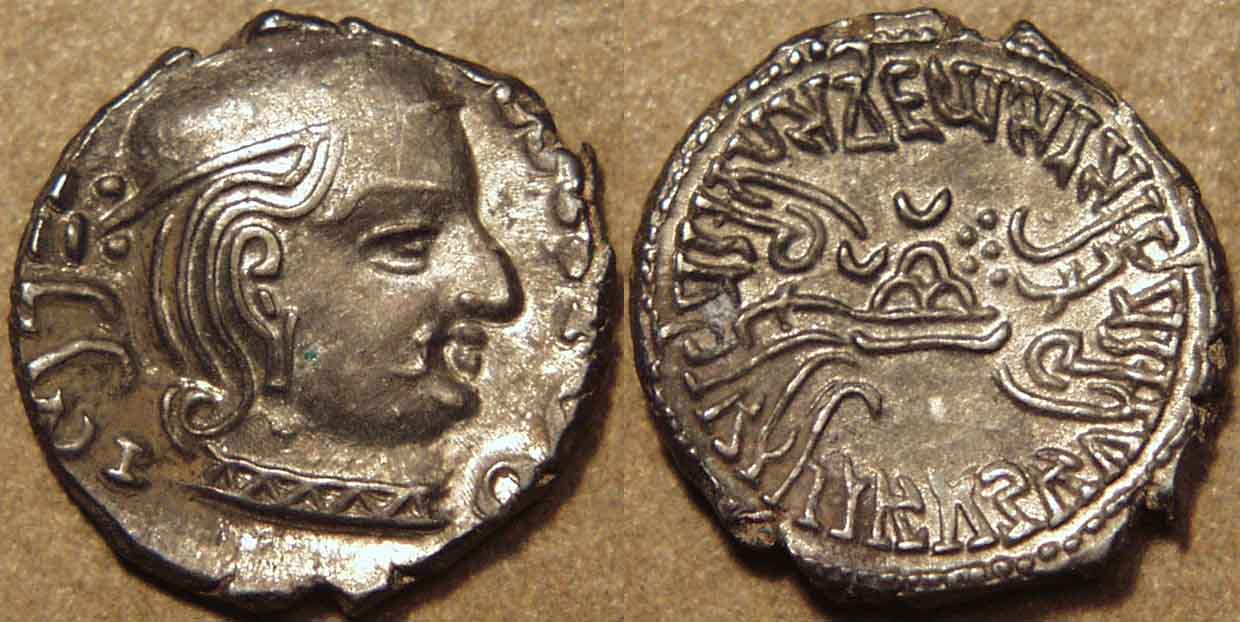
|
Coin #15:
Western Kshatrapas, Vijayasena, Silver drachma, 238-250 CE
Head of king right, Saka date 159 (=237 CE) behind head,
remnants of blundered "Greek" legend around /
Crescented three-arched hill, river below, sun and moon above, Brahmi legend around:
Rajno Mahakshatrapasa Vijayasenasa Rajno Mahakshatrapasa Daamasenaputrasa
Weight: 2.44 gm., Diam: 15 mm.
Ref: Senior 351.62, Jha & Rajgor 482-86 |
|
Coin 15 is representative of a remarkable coin series: the coins of a dynasty called the Western Kshatrapas, a Scythian dynasty that ruled a large kingdom in western India
from the 1st to the early 5th century. This dynasty produced a remarkably consistent series of silver coins from the beginning to the end of their rule. The coins have two features
of great interest. First, they typically name the king (entitled kshatrapa or mahakshatrapa) and his father, thereby giving us information with which to establish a lineage.
Second, starting in the year 178 CE and continuing for over 200 years, they are dated (in the Saka era, which commenced in the year 78 of the common era), so they also
provide specific dates for each of the rulers in that period. This has been of importance not only in establishing a firm chronology for the Western Kshatrapas, but also for dating
many kings of other dynasties known from inscriptions to have been contemporaries of individual Kshatrapa rulers.
The illustrated coin is a substitute for the coin in my original paper. That coin, a silver drachma of the Kshatrapa Viradaman, can be seen below (next coin). This coin is an issue
of the Mahakshatrapa Vijayasena, dated to the year 240. The Saka era date 162 is inscribed
behind the king's head on the obverse, interspersed among the letters of the blundered "Greek" legend, a residue from the copying of the portrait type from the Indo-Greek rulers.
The reverse features a three-arched, crescented hill (a Buddhist symbol), flanked above by a moon and sun, and surrounded by a finely inscribed Prakrit legend written in the
Brahmi script. It reads, starting at 9 o'clock: Rajno Mahakshatrapasa Vijayasenasa Rajno Mahakshatrapasa Daamasenaputrasa (of the King and Great Satrap
Vijayasena, son of the King and Great Satrap Daamasena). I elected to replace the original with the present coin because I had recently come across this coin and think it may
be the most beautiful Western Kshatrapa coin I have ever seen ... an absolute masterpiece of the celator's art. The calligraphy of the Brahmi legend is particularly stunning. Most
Western Kshatrapa coin legends lack some or all of the diacritics for the vowels, so it would not be unusual to see Vijayasena's name rendered as Vijayasana, or his father
Daamasena's name rendered as Damasana. But here all the diacritics are carefully rendered, and the overall arrangement of the letters and their long tails is simply
beautiful and highly artistic.
The Western Kshatrapas ruled a considerable kingdom, including parts of the modern states of Sind, Gujarat, Rajasthan, and Maharashtra, yet they called themselves
kshatrapas or satraps. Because the mightiest kingdom ruling during the early period of the Western Kshatrapas was that of the Kushans, many authors have concluded
that the Western Kshatrapas must have been feudatories or governors of the Kushan king. However, there is not very much evidence to support this conclusion and it could
well be instead that the dynasty may have started out as a feudatory of a Scythian king such as Azes II, continued to call themselves kshatrapas after asserting their
independence as a way of establishing their legitimacy to rule, and stuck with the practice more or less as a habit long after the main Scythian power had dissipated.
|

|
Coin #15A:
Western Kshatrapas, Viradaman, 234-238 CE
Head of king right, Saka date 159 (=237 CE) behind head,
remnants of blundered "Greek" legend around /
Crescented three-arched hill, river below, sun and moon above, Brahmi legend around:
Rajnah Kshatrapasa Viradamnah Rajno Mahakshatrapasa Damasenasaputrasa
Weight: 2.44 gm., Diam: 15 mm.
Ref: Senior 349.4D, Jha & Rajgor 452 |
|
This was the original coin #15 in my Celator article.
|
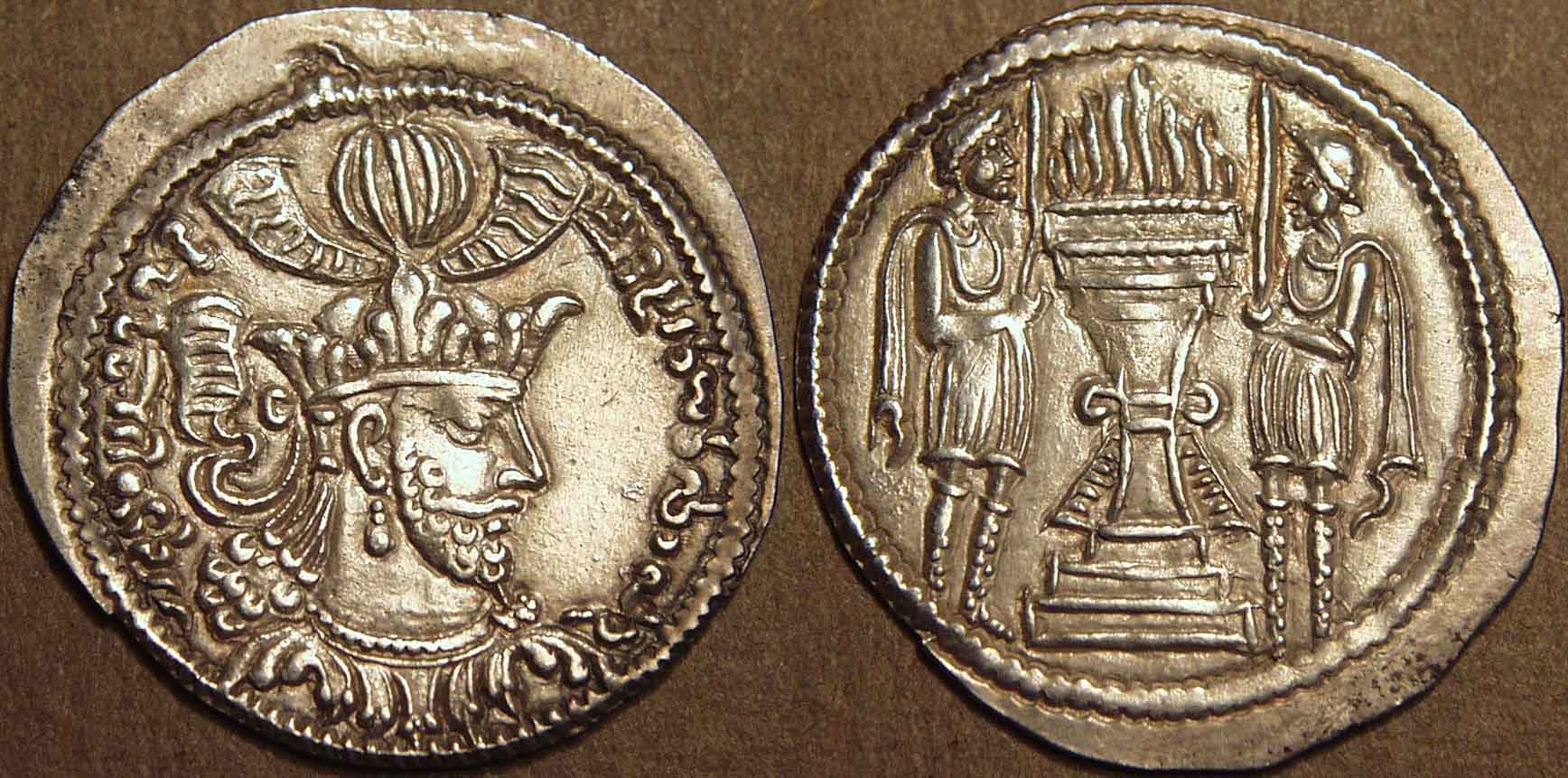
|
Coin #16:
Kushano-Sasanian or Kidarite, "Varahran", Silver drachma, c. 3rd century CE
Head of king right, Pahlavi legend at right /
Fire altar with attendants at left and right
Weight: 3.68 gm., Diam: 28 mm.
Ref: Göbl Hunnen 8 |
|
The Kushans controlled northern India for a period of well over 100 years. Huvishka's son Vasudeva (ruled c. 191-226) was the last of the great Kushan kings; he began to
face aggression from the west as the powerful Sasanians ruling in Iran began a program of chipping away at the northwest frontier of the kingdom. Eventually, under the
succeeding kings, the Kushan empire began to shrink and fragment.
The Sasanian incursion was begun by the founder of that dynasty Ardeshir I, who issued the first coins of Sasanian type in Bactria. The coinage developed, however, into a
hybrid of the Sasanian and Kushan types, and the kings began calling themselves Kushanshahs on the coins. Some coins were issued in the name of the Sasanian emperor,
but others were issued in the name of the local governors. Today, the dynasty is usually called the Kushano-Sasanians.
Somewhat later than the Kushano-Sasanians, a powerful Hun tribe known today as the Kidarites, descended on Bactria from Central Asia. The history of this tribe, and exactly
when they began their dominion, is still not fully understood.
Coin 16 is a Sasanian style silver drachm of Varahran (identified by the Pahlavi legend), who may be the Sasanian king Bahram I (273-276), but more likely a local Kushano-
Sasanian or Kidarite ruler. The coin is in the classic Sasanian style, on a very thin, broad flan, with a crowned bust of the king right on the obverse and a fire altar guarded
by two attendants on the reverse. The coin illustrates that the issuers were Zoroastrians, who worshipped fire. Some of the coins have a bust of their deity Ahura Mazda
emerging from the flames of the fire altar on the reverse. Most Kushano-Sasanian and Kidarite drachms of this type have rather flattened reverses, but this coin is exceptional in
terms of strike and preservation.
|
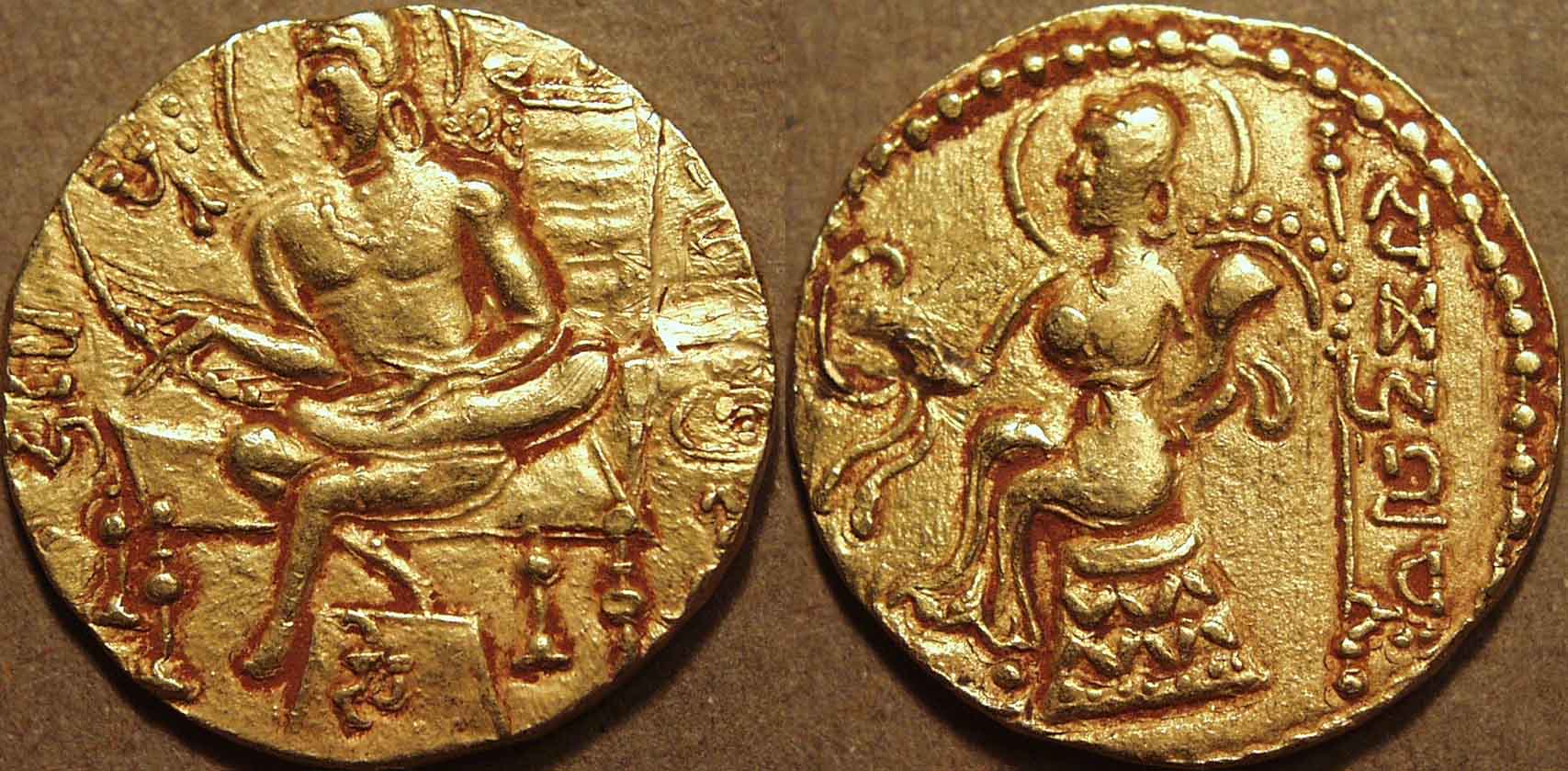
|
Coin #17:
Gupta Empire, Samudragupta, Gold dinar, c. 335-375 CE
King seated left on high-backed couch, playing veena
Brahmi legend around /
Lakshmi seated left on ornamental stool, holding diadem and cornucopia
Brahmi legend right: Samudragupta
Weight: 7.68 gm., Diam: 22 mm.
Ref: MAC 4788 |
|
As the Kushan empire crumbled and fragmented, many new and old kingdoms sprang up into existence around the periphery of the empire. One of these dynasties, destined
to rival the Kushan in size and strength, was that of the Guptas. Starting from a small kingdom in Magadha (modern Bihar) in the late 3rd century, the Gupta empire grew rapidly
under the leadership of Chandragupta I and his son Samudragupta. By the time of Chadragupta II in the late 4th century, the empire included all of northern India from the
Indus to the Brahmaputra and even extended south along the east coast of the peninsula.
The Gupta period is considered the Golden Age of classical India. This was a time when great universities flourished in Nalanda and Taxila, and great writers such as the
playwright Kalidasa and great scientists such as the mathematician and astronomer Aryabhatta, who is credited with the concept of zero among his many achievements,
helped create an atmosphere of tremendous creative impulse. Gupta art is regarded as the high point of classical Indian art, and the coinage is equally regarded as among the
most beautiful of ancient India.
Gupta coinage started out imitating that of the Kushans, but very soon new types were introduced. Coin 17 is a gold dinar of Samudragupta, known as the Lyrist type. On this
coin, the king is shown seated at ease on a high-backed couch, playing a string instrument like a simple lyre or lute. The fact that the king wanted to publicize an image of
himself as a musician is remarkable and a window into the value system of the Gupta state. Samudragupta is known to have been a great patron of the arts and was indeed
an accomplished musician and poet. On the reverse, we see the Hindu deity Lakshmi seated on a stool. She is nimbate, and holds a cornucopia in her left arm and a diadem
in her outstretched right hand. The Greek influence is obvious. There is also a legend naming the king: Samudragupta, following the practice on Greek coins from centuries
earlier.
For more coins of Samudragupta, see the Samudragupta gallery.
|

|
Coin #18:
Gupta Empire, Chandragupta II, Gold dinar, c. 375-414 CE
King standing right, shooting arrow at lion at right,
circular Brāhmī legend around /
Lakshmi (Durga?) seated facing on couchant lion left, holding diadem
and long-stemmed lotus, Brāhmī legend at right: Simhavikrama
Weight: 7.79 gm., Diam: 19 mm.
Ref: MAC 4814 |
|
Coin 18 is another new type, issued by Samudragupta's son Chandragupta II (c. 380-420). This type is entitled the "Lion-slayer" type, as it shows the king killing a lion, a device
no doubt aimed at publicizing the king's strength and skill. This coin is a sub-type referred to as the "Lion-trampler" type as the king is trampling the lion underfoot as he delivers
the final death blow. Note the serene face of the king, a reflection of the injunction from the Hindu scriptures to preserve calm and
serenity in the midst of the hurly-burly of the world.
The reverse of the coin shows Lakshmi once again, this time mounted on a couchant lion, the mount of the form of the Goddess known as Durga. Durga is a fierce goddess,
who is the slayer of many demons in Indian mythology. She is an apt deity for the reverse of the lion-slaying king. The legend on the reverse reads Simhavikrama, the
Lion Conqueror. The reverse also continues to bear a Kushan style tamgha (seen on the reverses of coins 13 and 14); it is not clear whether this was a meaningless vestige of
the old coinage, or whether the tamgha had true meaning in the Gupta context.
For more coins of Chandragupta II, see the Chandragupta II gallery.
|
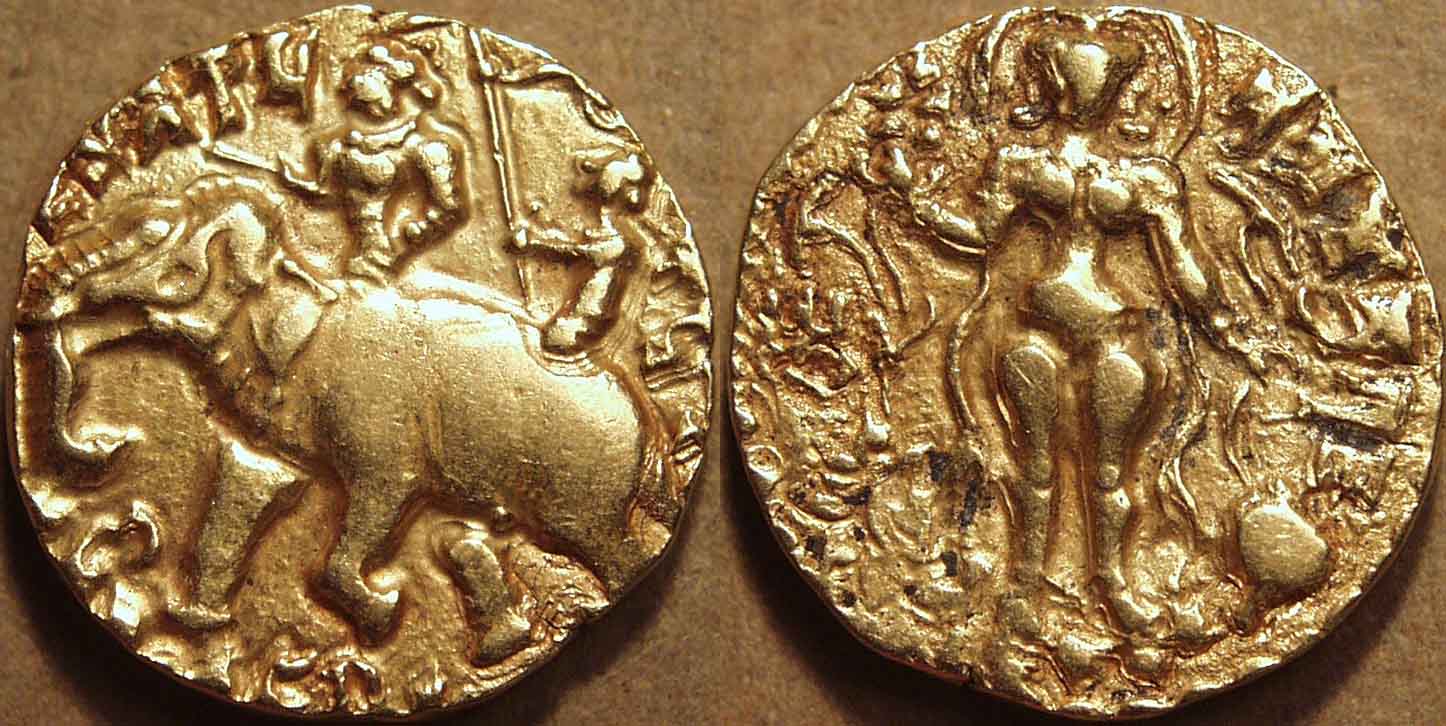
|
Coin #19:
Gupta Empire, Kumaragupta I, Gold dinar, c. 415-455 CE
King on elephant left, holding goad in right hand, attendant seated behind, holding up parasol,
circular Brāhmī legend around /
Lakshmi standing facing on a lotus, holding lotus in right hand,
and cornucopia in left hand, additional lotus in left field and sankh (conch) in right field,
Brāhmī legend at right: Sri Mahendragajah
Weight: 8.09 gm., Diam: 19 mm.
Ref: MAC --- |
|
Gupta art may have reached its zenith under Chandragupta II's son Kumaragupta (c. 415-455). Coin 19 is an issue of this
ruler ... the remarkable Elephant-rider type. This coin was no doubt designed to project an image of the emperor at his imperial best, riding a royal elephant, with an attendant
seated behind, holding a parasol to protect his majesty from the hot sun. The coin reprises Huvishka's elephant-rider type of some 300 years earlier (coin 14 above), and is
almost equally rare, as just a handful of these coins are known.
For more coins of Kumaragupta I, see the Kumaragupta I gallery. |
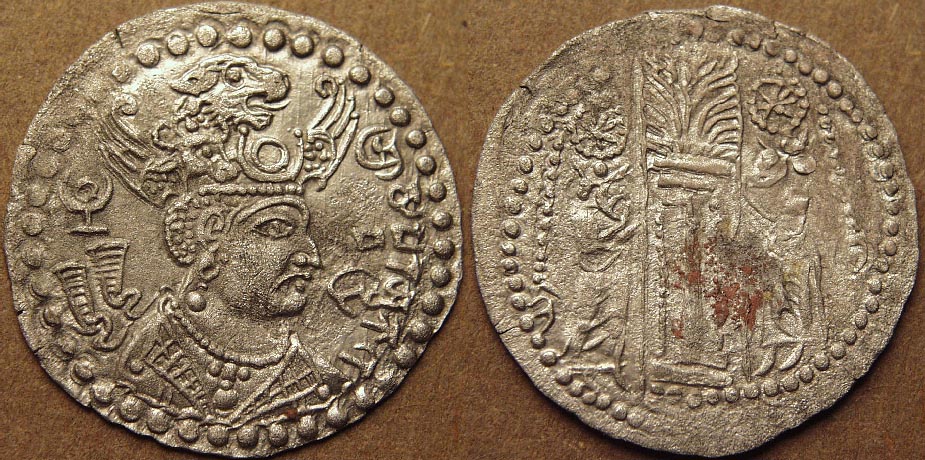
|
Coin #20:
Hunnic Kingdom, Vishvarazukare ?, silver drachm, c. 5th century CE
Diademed bust of king right, wearing fabtastic winged crown,
Tamgha at left, Brāhmī legend at right: Sri Vishvarazukare ? /
Fire altar flanked by attendants
Weight: 2.91 gm., Diam: 29 mm.
Ref: MAC --- |
|
The Golden Age of the Guptas lasted some 150 years. In the fifth century, Hunnic tribes from the northwest started to pose
a serious military challenge to the empire. Kumaragupta and later his son Skandagupta were able to initially repulse these invaders, but eventually the Huns were able to
establish a major presence in the northwest of India.
Hunnic coins frequently imitate Sasanian types, and coin 20 is an example of a rare coin of this type. It shows a king's bust
right in the Sasanian style, wearing a fantastic winged crown that features a sun and moon at the front, a bull's head behind that and a panther head on top, apart from the
eagle wings on the sides. We do not know who this king is and the legend on the coin has never been read. This coin is the first one to have a fully legible legend. The letter
forms are very complex, but I believe the legend reads Sri Vishvarazukare. The reverse of the coin features a traditional Sasanian style Zoroastrian fire altar, flanked by
two attendants. |
|
|